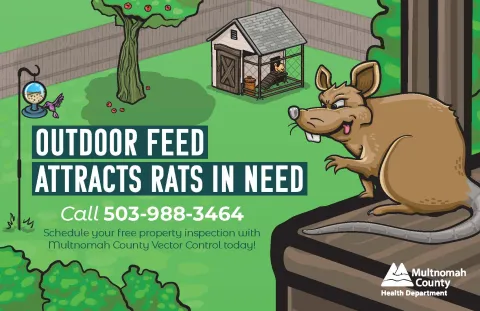
Have rats moved into your home or property?
Rats are attracted to places where they can access food. They may come for bird seed, chicken feed, garbage or downed fruit, and then move into your home or property.
The best way to control rats is to get rid of their food. Keep bushes and trees trimmed and pick up yard clutter.
If you’re dealing with rats inside your home, the first step is to inspect the outside of your home to find and seal any gaps. Next, figure out why rats are attracted to your home.
Rodents are a public health problem because they spread disease and damage property.
Free Property Inspection & Traps
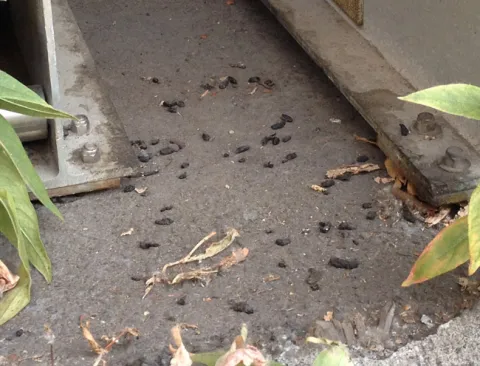
Although we're not exterminators, Multnomah County Vector Control can help you find the cause of your rodent problem. We can also give you free snap traps and advice.
To schedule a free property inspection, contact us at 503-988-3464, vector.nuisance@multco.us.
Signs of a Rodent Problem
- Rodent droppings (poop). Rats leave small, dark brown or black pellets. Mouse droppings are smaller, like grains of rice.
- Burrows (often hidden under vegetation, a wood pile, porch or deck) or runways outside
- You see rats, hear squeaking, hissing or chattering, or find chewed up material.
How to Get Rid of Rodents
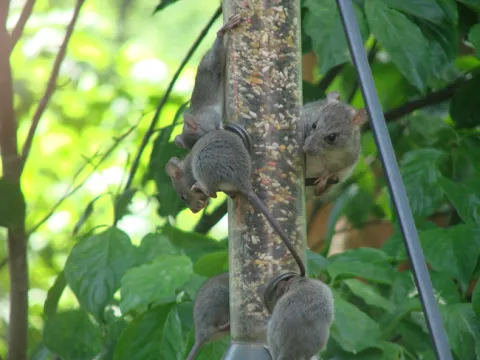
Step 1: Take Away Their Food
Common sources:
- Bird seed and suet
- Pet food
- Chicken feed
- Squirrel food
- Garbage
- Pet waste
- Backyard compost that has not been rodent-proofed
- Fallen fruit from trees or unharvested produce from gardens
The Portland Fruit Tree Project may be able to help you collect unharvested tree fruit for a fee.
Step 2: Trap Them
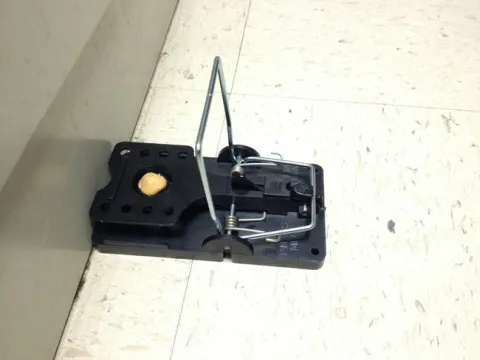
Snap traps are inexpensive and effective, and the preferred way to get rid of rodents indoors and out. Peanut butter makes good bait.
Set the trap in the area with the most rodent activity. Rodents tend to run along walls, so place traps next to a wall, fence line or foundation.
To keep children, pets and other animals safe from traps, use tamper-resistant bait stations.
Poisoning is not ideal, but is sometimes necessary. Poison is not recommended for indoor use, as rodents can die inside walls and produce odor.
Poison can also harm animals and pets. Always use poisons carefully in a secured bait station to keep poisons away from children, pets, and other animals.
Step 3: Keep Them Out of Your House
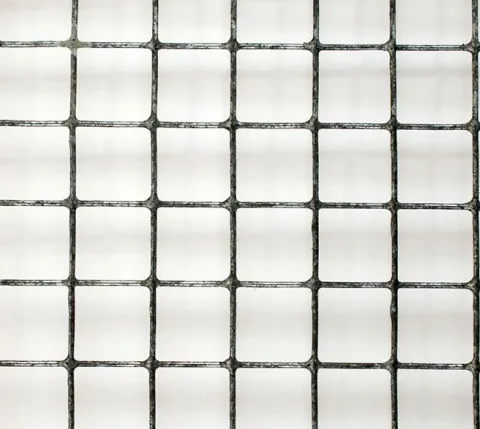
Rats can get in your home through small holes from the outside, such as your roof or crawl spaces.
To keep rodents out, seal openings the size of a dime or larger in homes, buildings and sheds:
- Where pipes or wires enter the building
- Under eaves
- In attics
- Around crawl space vents, foundations, doors and windows
Use cement, 1/4 inch steel hardware cloth (wire mesh, pictured), or steel wool and spray foam to seal gaps. Install or repair weather stripping around doors.
Trim back overhanging branches around the house to reduce roof rat access.
If you install a pet door, make sure it’s self-closing.
Step 4: Keep Them Out of Your Yard
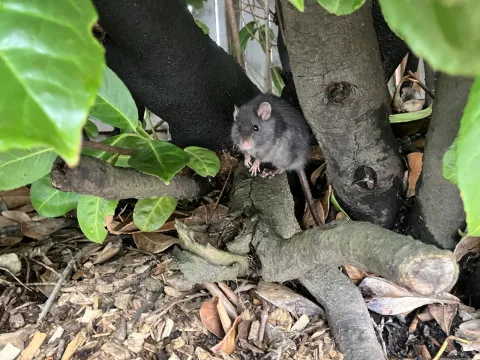
Don’t let your yard be a nesting zone for rodents. Keep bushes and trees trimmed and get rid of clutter. Rats will nest in:
- Outdoor piles of garbage and junk
- Under wood piles or lumber—stack wood piles 18 inches off the ground
- Overgrown blackberry bushes, shrubs, vines and tall grasses
Broken sewer line. If you live in Portland and see persistent holes in your parking strip, under the sidewalk or front yard, you may have a broken sewer line. Contact us or a private plumber for a dye test referral from the city.
Are rats coming from your neighbor’s property? Consider talking to your neighbor or property owner first. A neighborhood mediator can help you have productive a conversation and work out peaceful solution.
Step 5: Get Professional Help
If you have a bad infestation, you may need to contact a pest professional.
Although we’re NOT exterminators, Multnomah County Vector Control can give you free covered snap traps and advice. Schedule a free property inspection at 503-988-3464 or vector.nuisance@multco.us.
Step 6: Clean Up After an Infestation
Disinfect anything rodents have touched before you touch it.
Bleach and other cleaners can stain surfaces and be harmful if misused. ALWAYS follow labeled instructions.
Follow these steps to reduce your risk of exposure to disease:
- NEVER dry sweep or vacuum a rodent infested area. ALWAYS use wet cleaning methods.
- ALWAYS wear rubber gloves, long sleeves, protective eyewear and a dust mask when cleaning. This will protect you from contamination and contact with potentially harmful chemicals.
- Use a 10 parts water to 1 part chlorine bleach solution or a household disinfectant to clean contaminated areas.
- Put on gloves, then spray dead rodent with disinfectant.
- With gloves still on, pick up the rodent, place it in a bag and seal it. Place the bag in another bag and seal it. Put the bag in a covered outdoor trash can that is regularly emptied.
- When you’re done cleaning, wash your hands thoroughly with warm water and soap, and dry with paper towels. Launder your clothes normally.
More about cleaning up after a rodent infestation»
Rats on a Neighbor’s Property
Before you call us to report rats on a neighbor’s property, you MUST have evidence of rat activity either on, or coming from, THEIR property. Rat activity on your property does not count!
The evidence must be something we can photograph, such as:
- Rat droppings
- Burrows
- Runways
- Live rats
Report concerns about unsafe or unsanitary conditions in an urban campsite in Portland»
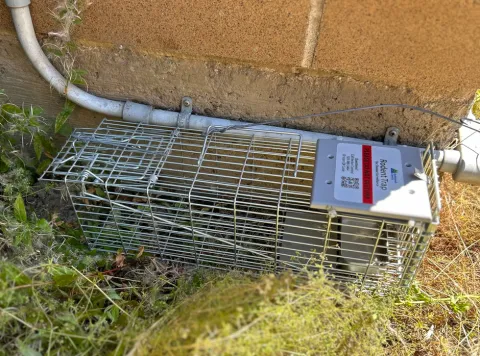
Did you find one of our rat traps?
We use these live traps to catch rats so we can monitor for rodent-borne diseases. They’re placed around the community (like in alleys) and left for several days.
If you see a trap, please don’t disturb it. We’ll remove it soon.
More Information
Centers for Disease Control & Prevention - Rodents
